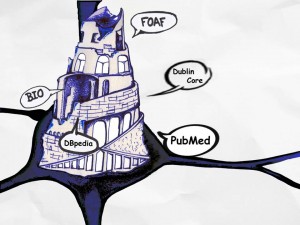What are the laws of information? Frank van Harmelen proposes seven laws of information science in his keynote to the Semantic Web community at ISWC2011. ((He presents them as “computer science laws” underlying the Semantic Web; yet they are laws about knowledge. This makes them candidate laws of information science, in my terminology.))
- Factual knowledge is a graph. ((“The vast majority of our factual knowledge consists of simple relationships between things,
represented as an ground instance of a binary predicate.
And lots of these relations between things together form a giant graph.”)) - Terminological knowledge is a hierarchy.
- Terminological knowledge is much smaller ((by 1-2 orders of magnitude)) than the factual knowledge.
- Terminological knowledge is of low complexity. ((This is seen in “the unreasonable effectiveness of low-expressive KR”: “the information universe is apparently structured in such a way that the double exponential worse case complexity bounds don’t hit us in practice.”))
- Heterogeneity is unavoidable. ((But heterogeneity is solvable through mostly social, cultural, and economic means (algorithms contribute a little bit). ))
- Publication should be distributed, computation should be centralized to decrease speed: “The Web is not a database, and I don’t think it ever will be.”
- Knowledge is layered.
I wish every presentation came with this sort of summary: slides and transcript, presented in a linear fashion. But these laws deserve more attention and discussion–especially from information scientists. So I needed something even punchier to share, (prioritized thanks to Karen).
